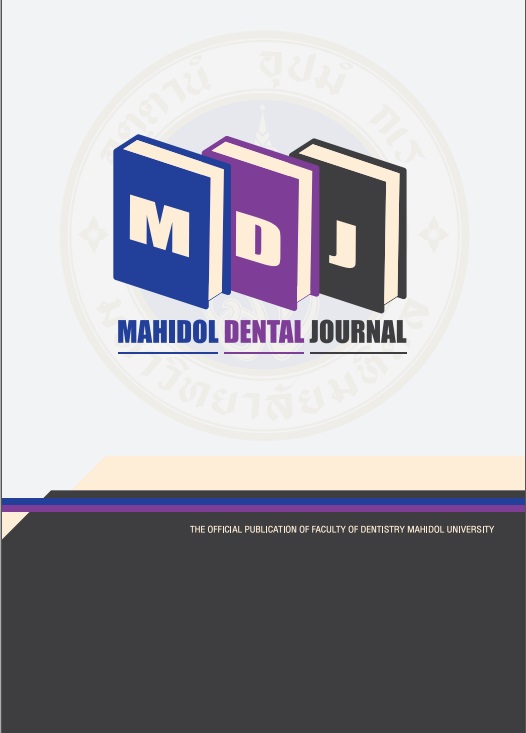The effect of a silane-SIO2 nanocomposite coating on a provisional restorative material on surface roughness
Main Article Content
Abstract
Objective: To investigate the effect of a silane-coating material on the surface roughness of a provisional fixed prosthodontic material and compare the changes in surface roughness after brushing.
Materials and Methods: Specimens were produced from four commercial provisional restorative materials (GC Unifast Trad™, Major C&B dentine, Protemp™ 4, Luxatemp® star) and a silane-coated provisional restorative material (coated-GC Unifast Trad™) and randomly divided into control and brushing groups. A profilometer was used to determine the surface roughness of each group's specimens. The surface morphology of the specimens from each group was examined using a scanning electron microscope (SEM).
Result: The roughness of the control groups was not significantly different. In the brushing groups, the coatedGC Unifast Trad™ roughness was significantly lower than that of GC Unifast Trad™. Furthermore, the coatedGC Unifast Trad™ roughness was not significantly different compared with Protemp™ 4 and Luxatemp® star.
Conclusion: The surface roughness of acrylic resin coated with a silane-SiO2 nanocomposite film is similar to that of conventional acrylic resin and bis-acryl composite resin. In contrast, the roughness of conventional acrylic resin is higher compared with coated acrylic resin after brushing, and acrylic resin coated with a silane-SiO2 nanocomposite film also has a roughness similar to that of bis-acryl composite resin.
Article Details

This work is licensed under a Creative Commons Attribution-NonCommercial-NoDerivatives 4.0 International License.
References
Turner KA, Missirlian DM. Restoration of the extremely worn dentition. J Prosthet Dent 1984; 52: 467-74.
Rosenstiel SF, Land MF, Fujimoto J, Lang SC. Contemporary fixed prosthodontics. 2001.
Patras M, Naka O, Doukoudakis S, Pissiotis A. Management of provisional restorations' deficiencies: a literature review. J Esthet Restor Dent 2012; 24: 26-38.
Astudillo-Rubio D, Delgado-Gaete A, Bellot-Arcís C, Montiel-Company JM, Pascual-Moscardó A, Almerich-Silla JM. Mechanical properties of provisional dental materials: A systematic review and meta-analysis. PloS one 2018; 13: e0193162.
Young HM, Smith CT, Morton D. Comparative in vitro evaluation of two provisional restorative materials. J Prosthet Dent 2001; 85: 129-32.
Quirynen M, Bollen C. The influence of surface roughness and surface‐free energy on supra‐and subgingival plaque formation in man: A review of the literature. J Clin Periodontol 1995; 22: 1-14.
Buergers R, Rosentritt M, Handel G. Bacterial adhesion of Streptococcus mutans to provisional fixed prosthodontic material. J Prosthet Dent 2007; 98: 461-9.
Kanter J, Koski RE, Martin D. The relationship of weight loss to surface roughness of composite resins from simulated toothbrushing. J Prosthet Dent 1982; 47: 505-13.
Goldstein GR, Lerner T. The effect of toothbrushing on a hybrid composite resin. J Prosthet Dent 1991; 66: 498-500.
Oliveira JCd, Aiello G, Mendes B, Urban VM, Campanha NH, Jorge JH. Effect of storage in water and thermocycling on hardness and roughness of resin materials for temporary restorations. Mater Res 2010; 13: 355-9.
Şen D, Göller G, Ìşsever H. The effect of two polishing pastes on the surface roughness of bis-acryl composite and methacrylate-based resins. J Prosthet Dent 2002; 88: 527-32.
Borchers L, Tavassol F, Tschernitschek H. Surface quality achieved by polishing and by varnishing of temporary crown and fixed partial denture resins. J Prosthet Dent 1999; 82: 550-6.
Chantarachindawong R, Luangtip W, Chindaudom P, Osotchan T, Srikhirin T. Development of the scratch resistance on acrylic sheet with basic colloidal silica (SiO2)—methyltrimethoxysilane (MTMS) nanocomposite films by sol–gel technique. Can J Chem Eng 2012; 90: 888-96.
Kamonwanon P, Hirose N, Yamaguchi S, Sasaki J-i, Kitagawa H, Kitagawa R, et al. SiO2-nanocomposite film coating of CAD/CAM composite resin blocks improves surface hardness and reduces susceptibility to bacterial adhesion. Dent Mater J 2017; 36: 88-94.
Kamonwanon P, Yodmongkol S, Chantarachindawong R, Thaweeboon S, Thaweeboon B, Srikhirin T. Wear resistance of a modified polymethyl methacrylate artificial tooth compared to five commercially available artificial tooth materials. J Prosthet Dent 2015; 114: 286-92.
Yodmongkol S, Chantarachindawong R, Thaweboon S, Thaweboon B, Amornsakchai T, Srikhirin T. The effects of silane-SiO2 nanocomposite films on Candida albicans adhesion and the surface and physical properties of acrylic resin denture base material. J Prosthet Dent 2014; 112: 1530-8.
Kumar GV, Devi R, Anto N. Evaluation and Comparison of the Surface Roughness and Porosity of Different Provisional Restorative Materials: An in vitro Study. CODS J Dent 2016; 8: 39-45.
Wang RL, Moore BK, Goodacre CJ, Swartz ML, Andres CJ. A comparison of resins for fabricating provisional fixed restorations. Int J Prosthodont 1989; 2: 173-84.
Lara-Jara NU, Romo-Ramírez GF, del Pilar Goldaracena-Azuara M, Aragón-Piñ A, Girón CB-T, Méndez-González MV, et al. Effect of Polishing Procedure on the Roughness and Bacterial Adhesion of Provisional Restorative Materials. Microsc Res 2018; 6: 9-18.
Haselton DR, Diaz‐Arnold AM, Dawson DV. Effect of storage solution on surface roughness of provisional crown and fixed partial denture materials. J Prosthodont 2004; 13: 227-32.


